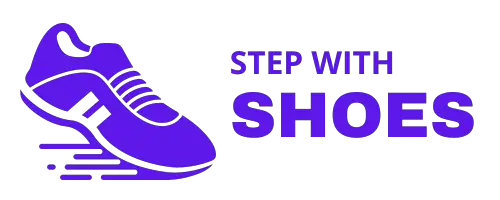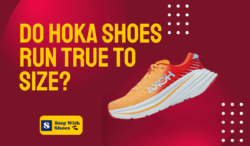Hoka shoes generally run true to size. They offer a comfortable fit for most customers.
Hoka shoes are known for their excellent fit and comfort. Whether you have narrow or wide feet, you can find a suitable size in the hoka shoe collection. The brand focuses on providing a snug fit that allows for optimal performance and prevents any discomfort during activities.
Their shoes are designed with high-quality materials and advanced technologies to ensure a perfect fit and enhance the overall running experience. Whether you are a professional athlete or a casual runner, hoka shoes are worth considering for their true-to-size fit and exceptional comfort.
Understanding Hoka Shoes Sizing
Hoka shoes are known for their unique and innovative designs that provide maximum comfort and support to runners and outdoor enthusiasts. However, when it comes to sizing, many people are unsure whether hoka shoes run true to size or if they have a different sizing system altogether.
In this section, we will delve into the factors that affect hoka shoe sizing, explain Hoka’s unique sizing system, and help you determine your ideal hoka size.
Factors Affecting Hoka Shoe Sizing
- Foot anatomy: The size and shape of your feet can greatly impact the fit of your hoka shoes. Some individuals may have wider or narrower feet, higher arches, or other specific foot characteristics that require a different size or width.
- Shoe model: Different hoka shoe models may fit slightly differently due to variations in design and construction. It’s important to consider the specific model you are interested in and any recommendations from hoka or fellow users regarding sizing.
- Personal preference: Some runners prefer a snug fit, while others prefer a little more room in their shoes. Your personal preference can also play a role in determining your ideal hoka size.
Hoka’s Unique Sizing System Explained
Hoka shoes follow a unique sizing system that may differ from traditional shoe sizing. Here are a few key points to understand about Hoka’s sizing:
- Half-size increments: Hoka offers half-size increments for most of its shoe models. This allows individuals to find a more precise fit and accommodate various foot shapes.
- Wide width options: Hoka also provides wide width options for select shoe models to cater to individuals with wider feet or those who prefer extra room in the toe box.
- Online resources: Hoka’s website provides a comprehensive sizing guide that includes measurements and recommendations for each specific shoe model. It’s worth taking a look at this guide to get a better understanding of how hoka shoes may fit you.
Determining Your Ideal Hoka Size
When it comes to determining your perfect hoka size, here are some general tips to consider:
- Measure your feet: Start by measuring both feet using a Brannock device or a ruler. This will give you a baseline measurement to compare with Hoka’s sizing guide.
- Consider the activity: Depending on whether you intend to use your hoka shoes for running, hiking, or everyday walking, you may have different sizing preferences. It’s important to factor in the specific activity and any recommendations or reviews from experienced users.
- Try before you buy: If possible, visit a local retailer or attend a hoka fitting event to try on different sizes and models. This can give you a better sense of how hoka shoes feel on your feet and help you make an informed decision.
Hoka shoe sizing requires considering various factors such as foot anatomy, shoe model, and personal preferences. While hoka follows a unique sizing system with half-size increments and wide-width options, it’s essential to take measurements, consult their sizing guide, and if possible, try on different sizes before making a purchase.
Finding the right hoka size ensures optimal comfort and performance during your activities.
Tips For Finding The Right Fit
Finding the perfect fit for your hoka shoes is essential for a comfortable and enjoyable running experience. Here are some tips to help you find the right fit:
How To Measure Your Foot Accurately
- Use a ruler or measuring tape to measure the length of your foot from the heel to the longest toe.
- Stand on a piece of paper and trace the outline of your foot. Measure the distance from the heel to the longest toe on the tracing.
- Refer to Hoka’s size chart to find your corresponding size based on the measurements of your foot.
Insights Into Hoka’s Sizing Variations By Model
- Hoka shoes may have slight variations in sizing depending on the model. It is important to check the sizing guide specific to the shoe you are interested in to ensure the best fit.
- Some hoka shoes are known to run true to size, while others may run slightly smaller or larger than the standard sizing. Reading customer reviews can also provide insight into the fit of a particular shoe model.
Understanding Different Shoe Widths And Their Impact On Fit
- Shoe widths can vary between different brands and models, and understanding your foot’s width can help you find a better fit.
- Hoka offers shoes in different widths, including standard width (b for women and d for men) and wide width (d for women and 2e for men).
- If you have wider feet, opting for a wider width can prevent discomfort and ensure a proper fit.
Finding the right fit for your hoka shoes is crucial to avoid discomfort or potential injury while running. By accurately measuring your foot, considering sizing variations by model, and understanding different shoe widths, you can ensure a comfortable fit that will support your running goals.
Take the time to find the perfect fit, as it can greatly enhance your overall running experience.
An Inside Look At Customer Experiences

Hoka shoes have become increasingly popular among runners, hikers, and fitness enthusiasts for their unique cushioning technology and comfortable feel. However, when it comes to purchasing a pair of hoka shoes, many individuals wonder if they run true to size.
To provide you with some insights, let’s take an inside look at customer experiences regarding size accuracy.
Reviews From Hoka Shoe Users Regarding Size Accuracy:
- It’s important to note that individual experiences may vary when it comes to sizing. However, based on numerous customer reviews, there are some common trends and patterns to look out for.
- Many users mentioned that hoka shoes tend to run slightly smaller than their usual size. It is often recommended to size up by half a size or even a full size to ensure a proper fit.
- Some customers found that the toe box of hoka shoes is more spacious compared to other brands. This extra room allowed for more comfort, especially for individuals with wider feet.
- On the other hand, a few users reported that hoka shoes fit true to size for them. These individuals did not experience any sizing issues and were satisfied with their usual shoe size.
Common Trends And Patterns To Look Out For:
- Some reviewers suggested that certain hoka shoe models may have different sizing characteristics. It’s essential to consider specific recommendations provided by both the brand and other customers for the particular style you intend to purchase.
- Wearing thicker socks or utilizing additional insoles can also impact how hoka shoes fit. It’s worth considering these factors when deciding on your size.
- Taking accurate measurements of your feet and referencing the brand’s size chart can also be helpful in determining the right size. Each person’s feet are unique, so it is advisable to rely on precise measurements rather than assumptions.
Real-World Advice For First-Time Hoka Shoe Buyers:
- If you are a first-time hoka shoe buyer, it’s recommended to visit a local store and try on different sizes and models. This will allow you to get a better understanding of how their shoes fit and which specific style suits you best.
- Reading multiple customer reviews and seeking advice from experienced hoka shoe users can provide valuable insights. Keep in mind that everyone’s feet are different, so consider reviews along with your own preferences and comfort.
- If you decide to order online, it is crucial to purchase from a reputable retailer with a flexible return policy. This way, if you need to exchange sizes or models, you can do so easily without any hassle.
- Don’t be afraid to reach out to hoka customer service for guidance on sizing. They are knowledgeable about their products and can provide personalized assistance to ensure you find the right fit.
By taking into account customer experiences, common trends, and real-world advice, you can make an informed decision when purchasing hoka shoes. Remember that finding the perfect size is essential for your overall comfort and enjoyment of these highly regarded footwear options.
Do Hoka Shoes Run True to Size?
Analyzing Customer Feedback to Determine Sizing Consistency
At the heart of our investigation into Hoka shoe sizing is a thorough examination of customer feedback and reviews. We’ve taken the time to sift through numerous accounts from Hoka enthusiasts to get a clearer picture of whether these shoes indeed run true to size. While individual experiences can vary, trends and patterns have emerged that shed light on this critical aspect of choosing the right pair of Hoka shoes.
Do Hoka Shoes Tend to Run True to Size, or Are There Sizing Concerns?
In our extensive research, we’ve found that the overwhelming majority of Hoka customers report a positive experience when it comes to sizing. Most individuals find that Hoka shoes align with their usual sizing expectations. For instance, if you typically wear a size 10 in other athletic shoe brands, chances are a size 10 in Hoka will provide a comfortable fit. However, it’s important to acknowledge that there have been occasional reports of sizing discrepancies.
These outliers typically stem from specific shoe models or designs within the Hoka lineup. While the brand as a whole maintains a reputation for consistency, certain models may exhibit subtle variations. It’s crucial to consider the intended use and design specifics of the shoe you’re interested in. To navigate these nuances effectively, Hoka One One has taken proactive steps by offering comprehensive sizing charts and guidelines on its official website. These resources empower customers to make well-informed decisions based on foot measurements and shoe specifications.
Insights into Hoka Models with Unique Sizing Characteristics
Diving deeper into our research, we’ve pinpointed specific Hoka models that have garnered attention regarding sizing tendencies. For example, the Hoka Clifton series, celebrated for its lightweight construction and exceptional cushioning, tends to align closely with customers’ true sizes. On the other hand, models like the Hoka Speedgoat, designed for challenging trails and technical terrain, have occasionally prompted wearers to opt for a half-size larger due to their snug fit.
How To Navigate Hoka Shoe Size Charts
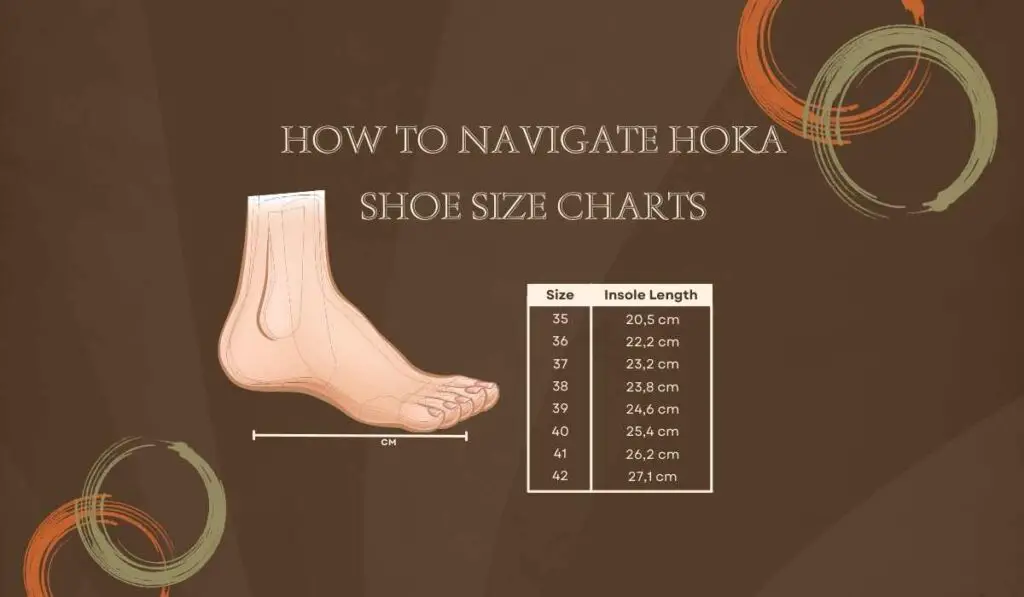
Deciphering Hoka’s Size Charts Effectively
When it comes to buying running shoes online, it’s crucial to get the right size for a comfortable and secure fit. Hoka, a popular brand known for its cushioned and supportive shoes, provides size charts to help customers make informed decisions.
Understanding and navigating these size charts can save you from the hassle of returns and exchanges. Here are some tips to decipher Hoka’s size charts effectively:
- Refer to the shoe-specific size chart: Hoka provides separate size charts for each of their shoe models. Before making a purchase, identify the specific model you’re interested in and find its corresponding size chart.
- Measure your feet accurately: To determine your size accurately, start by measuring your feet using a ruler or measuring tape. Measure both feet and use the larger measurement to determine your size. Refer to Hoka’s recommended measurement technique for precise results.
- Take into account any foot conditions: If you have wide feet, high arches, or any other foot conditions, consider sizing up or down accordingly. Hoka often provides additional recommendations in their size charts for individuals with specific foot needs.
- Pay attention to half sizes: Hoka offers half sizes in many of their shoe models. If you typically wear a half size, it’s beneficial to check if the specific shoe you’re interested in offers that size. Choosing the appropriate half-size can ensure a more accurate fit.
- Consider the shoe’s intended use: Keep in mind that certain shoe models within the hoka range may have different sizing guidelines based on their intended use. If you’re purchasing a shoe for trail running or walking, for example, the size recommendations might differ slightly.
- Read customer reviews: Customer reviews can offer valuable insights into the accuracy of Hoka’s size recommendations. Take the time to read reviews from individuals with similar foot profiles to see if they found the shoes true to size or if any adjustments were necessary.
Tips For Evaluating The Accuracy Of Size Recommendations
To confidently evaluate the accuracy of Hoka’s size recommendations and ensure a perfect fit, consider the following tips:
- Measure your feet at different times of the day: Our feet tend to swell slightly throughout the day, so measuring them in the morning and later in the day can help determine if size adjustments are needed.
- Assess the toe box: When trying on hoka shoes, make sure there is enough room for your toes to wiggle comfortably. A snug fit is essential, but you don’t want your toes to feel cramped or restricted.
- Consider sock thickness: If you plan to wear specific socks with your hoka shoes, take their thickness into account when determining your size. Thicker socks may require slightly more wiggle room.
- Try on multiple sizes: If you’re uncertain about your size based on the recommendations, it may be beneficial to try on multiple sizes to find the perfect fit. Remember that each foot can vary slightly in size, so it’s essential to consider the overall comfort and fit of both shoes.
Comparing Hoka’s Sizes With Other Popular Shoe Brands
In addition to understanding Hoka’s size charts, it can be helpful to compare their sizes with other popular shoe brands to gauge consistency or identify any differences. Here’s how Hoka’s sizes align with some other well-known brands:
- Nike: Hoka shoes generally run true to size when compared to Nike. If you typically wear a specific size in Nike shoes, it’s recommended to choose the same size in hoka, unless significant feedback suggests otherwise for a specific model.
- Brooks: Hoka’s sizes are generally comparable to Brooks, with minimal variations reported by customers. Stick to your usual Brooks size when considering hoka shoes.
- New Balance: Hoka and new balance sizing tend to align well, but some individuals have reported hoka shoes running slightly smaller. Consider going up a half size when transitioning from new balance to hoka.
- Adidas: Hoka and Adidas sizes are often similar, but it’s important to check customer reviews for specific models, as occasional variations have been noted. If you’re accustomed to Adidas sizing, try selecting the same size in hoka unless advised otherwise.
Remember, size recommendations can vary depending on foot measurements, shoe models, and personal preferences, so it’s essential to consider all these factors when choosing the perfect size. By following these tips and comparing sizes with other brands, you’ll enhance your chances of selecting the ideal fit when purchasing hoka shoes online.
Expert Insights From Hoka’s Sizing Team
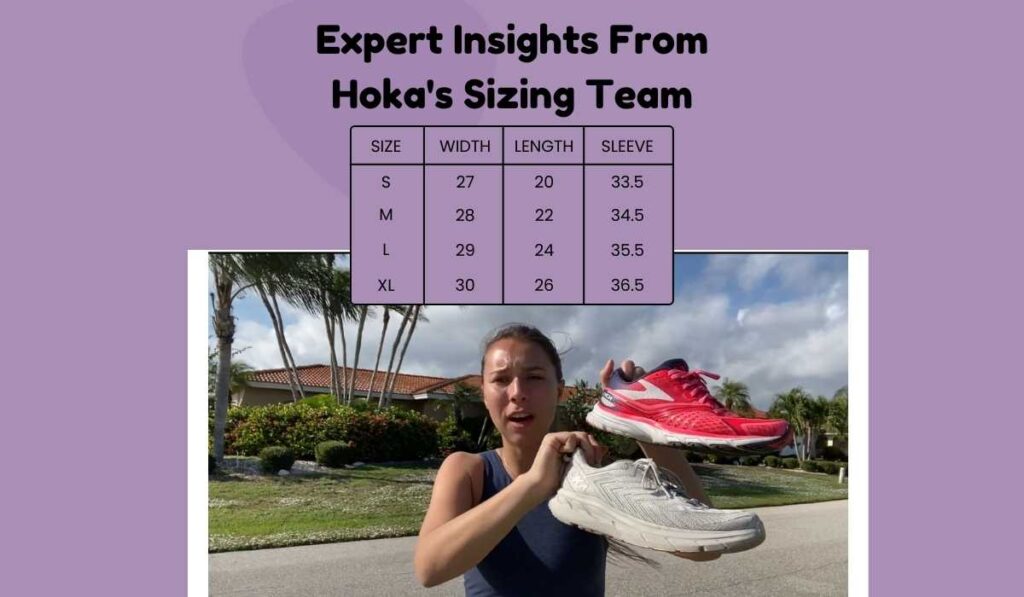
When it comes to finding the perfect fit for your hoka shoes, it’s important to understand the insights and recommendations from hoka’s team of sizing specialists. These experts have delved deep into the science behind Hoka’s sizing methods and have insider tips to help you achieve a true-to-size fit.
Let’s dive into their valuable insights:
Interview With Hoka’s Sizing Specialists
- Understanding foot size and shape: Hoka’s sizing team emphasizes the significance of considering both foot length and width when selecting the right shoe size. They suggest measuring your feet using a Brannock device and consulting the hoka size chart to determine the best fit.
- Different models, different fits: Hoka offers a wide range of shoe models, each designed with specific features and purposes in mind. The sizing team advises that shoe fit may vary across different hoka models due to variations in constructions, materials, and intended uses.
- Half sizes availability: Hoka takes pride in providing half sizes for most of their shoe models. This allows for a more precise fit, particularly if you find yourself between two whole sizes. The specialists recommend trying both the whole size and the corresponding half size to find the best match.
Understanding The Science Behind Hoka’s Sizing Methods
- Innovative shoe engineering: Hoka takes a scientific approach to shoe design, incorporating advanced technologies and biomechanical research. The sizing team ensures that each shoe size is carefully optimized to deliver the best performance, stability, and comfort.
- Proportional adjustments: Hoka’s sizing experts employ proportional adjustments to accommodate different foot shapes. By analyzing various measurements and anatomical considerations, they aim to provide a consistent fit throughout the size range of each shoe model.
- Thorough testing and feedback: Hoka’s sizing methods are refined through rigorous testing and feedback loops. The team collaborates with athletes, testers, and real-world users to gather insights and make necessary adjustments, ultimately ensuring a true-to-size fit and high customer satisfaction.
Insider Tips For Achieving A True-To-Size Fit
- Visit a local store for expert assistance: If you’re uncertain about your exact shoe size or have specific fitting concerns, the sizing team recommends visiting a local hoka retailer. The knowledgeable staff can provide personalized advice and assist you in finding the perfect shoe size.
- Try different styles and models: As mentioned earlier, hoka offers a variety of shoe models, each designed with unique features. The sizing specialists suggest trying different styles to find the one that suits your foot shape, preference, and intended usage the best.
- Consider individual preferences and activities: It’s important to take into account your personal preferences and activities when selecting a shoe size. Whether you prefer a snug or roomier fit, or if you engage in activities that may require additional toe space or support, these factors should influence your sizing decision.
- Read customer reviews: When in doubt about which size to choose, the experts recommend reading customer reviews. Many hoka users often provide valuable insights regarding the shoe’s fit, sizing accuracy, and any specific recommendations.
By following the guidance and recommendations from Hoka’s sizing team, you’ll be well-equipped to find a true-to-size fit with your hoka shoes. Remember to consider your foot measurements, try different models, and seek expert assistance when needed. Happy running or walking!
Factors To Consider Beyond Sizing
Foot Shape And Pronation Considerations
When it comes to finding the right fit for your hoka shoes, it’s important to consider more than just the sizing. Your foot shape and pronation can play a significant role in how the shoes feel and perform on your feet.
Here are some key points to keep in mind:
- Understanding your foot shape: Everyone’s feet are unique, and understanding your foot shape can help guide you towards the right hoka shoe style. Consider whether you have wide feet, narrow feet, or high arches, as this can impact the fit and comfort of the shoes.
- Pronation and stability: Pronation refers to the natural inward rolling motion of the foot as it strikes the ground. It’s crucial to know whether you have a neutral pronation, overpronation, or underpronation (also known as supination). Different hoka shoes offer varying levels of stability and support to cater to different pronation types.
- Seek expert advice: If you’re uncertain about your foot shape or pronation, it’s worth consulting with a professional, such as a podiatrist or specialized shoe store staff. They can analyze your feet and provide recommendations tailored to your specific needs.
Choosing The Appropriate Hoka Shoe Style For Your Activities
Hoka offers a wide range of shoe styles, each designed to cater to different types of activities and terrains. Consider the following points when selecting the right shoe style:
- Road running: If you primarily run on paved roads or other hard surfaces, road running shoes from hoka provide excellent cushioning and support for optimal comfort and performance.
- Trail running: For off-road adventures, hoka offers trail running shoes that feature durable outsoles, enhanced traction, and added protection to tackle uneven terrains.
- Hiking and backpacking: Hoka’s hiking shoes are designed to provide stability, comfort, and durability for long hikes and carrying heavy backpacks. Look for features like sturdy toe bumpers and supportive midsoles.
- Walking and casual wear: Hoka also offers shoes suitable for everyday walking and casual wear. These shoes are often lightweight, comfortable, and stylish, making them a great choice for all-day comfort.
Understanding The Importance Of Spacious Toe Boxes
Beyond sizing, the toe box is a crucial consideration for ultimate comfort and foot health. Hoka shoes are known for their roomy toe boxes, and here’s why it matters:
- Maintaining natural foot splay: A spacious toe box allows your toes to spread out naturally inside the shoe, supporting the foot’s natural structure and providing ample space for movement.
- Comfort and reduced pressure: When your toes have sufficient wiggle room, you’ll experience less discomfort, pressure, and potential issues like blisters or ingrown toenails during activities.
- Accommodating orthotics and inserts: If you use orthotics or custom inserts, a generous toe box provides the necessary space for these inserts without compromising comfort or fit.
- Improved balance and stability: Having more room in the toe box enables better balance and stability, allowing your toes to engage and provide a solid foundation during movement.
Remember, finding the perfect fit is a personal journey, and it may take some trial and error to determine the ideal hoka shoe size and style for your unique feet and activities. By considering factors like foot shape, pronation, and toe box spaciousness, you’ll be well on your way to discovering the ultimate comfort and performance with hoka shoes.
The Impact Of Shoe Material On Fit

How Different Materials Can Affect Shoe Sizing
When it comes to shoe sizing, one important factor to consider is the material used in the construction of the shoe. Different materials can have an impact on how true to size a shoe runs. Understanding the influence of material on fit can help you make more informed decisions when choosing a pair of hoka shoes.
Here are some insights into Hoka’s use of various materials in their shoes:
- Mesh: Hoka often incorporates mesh material in their shoes, which offers breathability and flexibility. Shoes with mesh uppers tend to have a more forgiving fit and can accommodate wider feet or those with higher arches.
- Synthetic overlays: Hoka uses synthetic overlays to provide structure and support to their shoes. These overlays can affect the fit by adding more rigidity, particularly around the midfoot and heel areas. If you prefer a snug fit or need added stability, look for hoka shoes with synthetic overlays.
- Engineered mesh: Hoka also utilizes engineered mesh in some of its models. This type of mesh is strategically designed to optimize breathability, comfort, and fit. The engineered mesh allows for targeted support and ventilation in specific areas of the shoe, improving fit accuracy.
- Lycra: In certain hoka shoes, you may find lycra material incorporated into the upper. Lycra offers a stretchy and adaptive fit, conforming to the shape of your foot for a more personalized feel. This can be particularly beneficial for individuals with irregular foot shapes or those seeking a glove-like fit.
- Tpu (thermoplastic polyurethane): Hoka incorporates Tpu in the midsole and outsole of some of their shoes. TPU provides durability, stability, and enhanced traction. While it does not directly impact fit, the use of tpu can affect the overall performance and feel of the shoe.
Tips for choosing the right material for your fit preferences:
- Determine your specific fit needs. Consider factors such as foot width, arch height, and any existing foot conditions or sensitivities.
- Evaluate the shoe’s intended use. Are you looking for a shoe for long-distance running, trail running, or everyday walking? Consider how the chosen material may contribute to the comfort and performance of the shoe in your desired activity.
- Seek professional guidance. If you’re unsure about your foot type or have persistent fit issues, it’s always beneficial to consult with a professional shoe fitter or podiatrist. They can offer personalized recommendations based on your unique requirements.
- Understand that fit preferences can vary. Some individuals prefer a snug and supportive fit, while others prefer a more relaxed and roomy feel. Experiment with different materials to find what works best for you and your feet.
Remember, each individual’s feet are unique, and what works for one person may not work for another. By considering the material used in the construction of hoka shoes and how it can affect fit, you can make a more informed decision when selecting your next pair.
Ensuring A Comfortable Fit: Testing Hoka Shoes
When it comes to finding the perfect running shoe, fit and comfort are essential factors to consider. As an avid runner, you want to make sure that your footwear not only matches your running style but also ensures a comfortable and supportive fit.
This is where hoka shoes come into play. Hoka is known for its innovative design and cushioned feel, but do their shoes run true to size? Let’s dive into the process of testing hoka shoes to ensure a comfortable fit.
Best Practices For Trying On Hoka Shoes:
- Measure your feet: Start by measuring the length and width of your feet. This will give you a better understanding of which size to consider when trying on hoka shoes.
- Use the hoka size chart: Hoka provides a size chart on their website that helps you determine which size will be the closest match for your feet based on your measurements. Refer to this chart when selecting your size.
- Consider your running needs: Think about the type of running you do and any specific requirements you may have. For example, if you have flat feet, you may need additional arch support or a specific type of cushioning.
- Select the right socks: When trying on hoka shoes, make sure to wear athletic socks that you would normally wear while running. This will give you a more accurate feel of how the shoes will fit during your workouts.
Evaluating The Fit And Comfort During Wear:
- Walk around: Take a few steps around the store or your home to get a sense of how the shoes feel. Pay attention to any pressure points or discomfort, especially in the toe box or heel area.
- Check for wiggle room: Hoka shoes should provide enough space for your toes to wiggle comfortably. Ensure that there is ample room in the toe box and that your feet feel secure but not cramped.
- Assess arch support: If you need arch support, check if the shoes provide enough stability and cushioning in that area. Hoka shoes are known for their excellent arch support, but it’s always good to double-check.
- Consider the cushioning: Hoka shoes feature generous cushioning, so make sure they feel supportive and comfortable as you walk or run. Pay attention to any pressure points or inconsistencies in cushioning across the shoe.
Troubleshooting Common Fit Issues And Finding Solutions:
- Heel slippage: If you experience heel slippage, try tightening the laces in the upper part of the shoe or using a different lacing technique, such as the heel lock method, to secure your foot in place.
- Tight toe box: If the toe box feels tight, consider trying a half-size larger or looking for hoka shoes with a wider fit option.
- Arch discomfort: If you find that the arch support is causing discomfort, try different insoles that provide better customization and support for your arch type.
- Inconsistent cushioning: If you notice inconsistent cushioning within the shoe, it may be a manufacturing defect. Contact hoka customer support for assistance or consider exchanging the shoes.
By following these best practices and evaluating the fit and comfort during wear, you’ll be able to find the perfect hoka shoe that suits your running needs. Remember, each person’s feet are unique, so take the time to try on different models and sizes to find the ideal fit.
Happy running!
Returning And Exchanging Hoka Shoes
Hoka’s Return Policy And Guidelines
If you’ve purchased a pair of hoka shoes online and they don’t quite fit the way you expected, don’t worry! Hoka has a straightforward return policy and guidelines to ensure your satisfaction. Here are the key points you need to know:
- Hoka offers a 30-day return window, starting from the day you receive your order.
- The shoes must be in unused and new condition, with the original packaging and tags intact.
- Make sure to include the packing slip or order confirmation when returning your shoes.
- Hoka does not cover the cost of return shipping, so you will be responsible for the return shipping fees.
Tips For Hassle-Free Returns And Exchanges
Returning or exchanging shoes can sometimes be a hassle, but with these tips, the process will be a breeze:
- Carefully read and understand Hoka’s return policy before making a purchase. This will help you avoid any unexpected surprises.
- Try on your hoka shoes indoors on a clean surface to avoid any damage or dirt before deciding to keep them.
- If you have any doubts about the size, consider ordering multiple sizes to find the perfect fit. This way, you can easily return or exchange the pairs that don’t work for you.
- Keep the original packaging and tags intact until you’ve determined that the shoes fit properly. This will make it easier to return or exchange them if needed.
- When returning the shoes, securely package them to prevent any damage during transit. It’s also a good idea to use a trackable shipping method to ensure the package reaches hoka successfully.
Understanding Warranty Coverage For Size-Related Issues
Hoka understands that sometimes sizing issues might arise, and they have warranty coverage in place to address such situations. Here’s what you need to know:
- Hoka offers a one-year warranty, covering manufacturers’ defects, including size-related issues.
- If you believe your hoka shoes have a sizing defect, contact Hoka’s customer service and provide them with the necessary details about your purchase.
- The warranty does not cover normal wear and tear, damage from improper use, or damage caused by accidents.
Remember, hoka wants you to have the best-fitting shoes possible, so don’t hesitate to reach out to their customer service team if you encounter any size-related issues. They will be happy to assist you in finding a solution.
So, if you’ve been wondering whether hoka shoes run true to size, rest assured that hoka has a clear return policy and guidelines in place to make the process hassle-free for you. Keep these tips in mind and don’t hesitate to take advantage of Hoka’s warranty coverage if needed.
Do Running Shoes Fit True to Size?
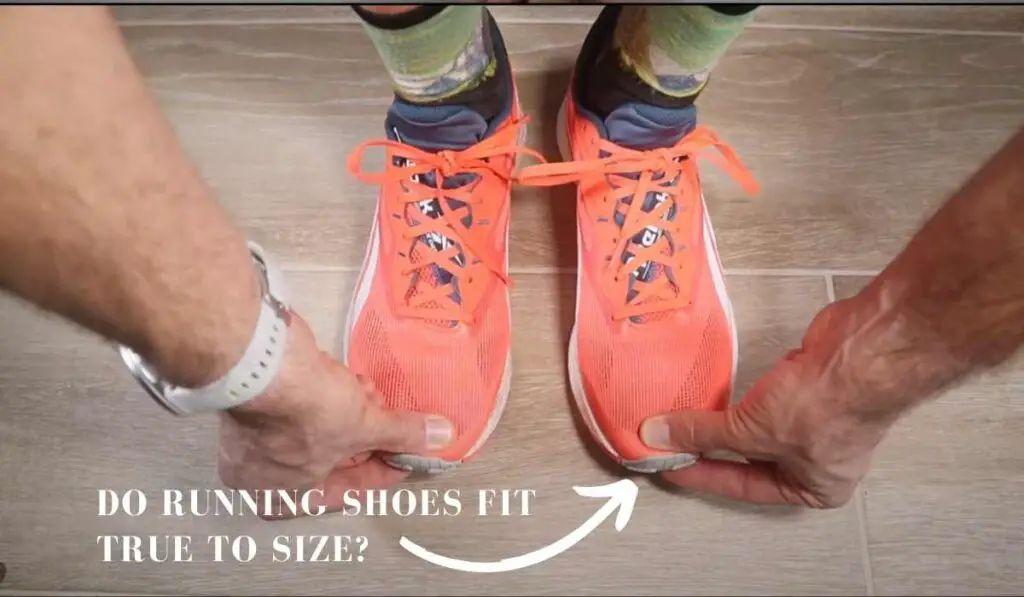
One of the most common questions runners and athletes face when buying running shoes is whether they fit true to size. The answer to this question can vary depending on several factors, including the brand, model, and even individual preferences and foot characteristics.
Factors Affecting Running Shoe Sizing
Several factors come into play when determining if running shoes fit true to size. Firstly, it’s important to understand that different brands and even different models within the same brand may have slight variations in sizing. Therefore, what fits perfectly in one brand might not necessarily be the same in another.
Additionally, foot shape and width play a crucial role. Runners with narrow or wide feet may find that they need to adjust their sizing preferences to ensure a comfortable fit. Understanding your own foot characteristics, such as arch height and pronation tendencies, can also impact your choice of running shoe size.
Brand and Model Specifics
Each running shoe brand tends to have its own sizing standards. For example, some brands are known for running true to size, while others may have a reputation for sizing slightly larger or smaller. It’s essential to consider brand-specific sizing charts and guidelines when making a purchase decision.
Moreover, within a single brand, different running shoe models may fit differently. Performance-oriented shoes designed for racing or speed may have a snugger fit, while cushioned or stability shoes could offer a more relaxed fit. Researching and trying on various models can help you find the right size for your specific needs.
Personal Preferences and Comfort
Beyond technicalities, personal comfort preferences play a significant role in determining whether running shoes fit true to size. Some runners prefer a snug fit for a secure and responsive feel, while others opt for a slightly roomier fit for added comfort during long-distance runs. It’s essential to strike a balance between your preferred fit and the shoe’s intended purpose, as excessively tight or loose shoes can lead to discomfort and potential injury.
The question of whether running shoes fit true to size is multifaceted. It depends on various factors, including brand, model, foot characteristics, and personal preferences. To make an informed decision, it’s advisable to consult brand-specific sizing charts, read customer reviews, and, whenever possible, try on the shoes or order from retailers with flexible return policies. Ultimately, finding the right running shoe size is a crucial step in enhancing your running experience, as it directly impacts comfort, performance, and injury prevention.
Do Hoka Shoes Run Large or Small?
Determining whether Hoka shoes run large or small is a common concern for potential buyers. The answer to this question can vary depending on the specific model and individual preferences, making it essential to consider various factors when assessing the sizing of Hoka footwear.
Factors Influencing Hoka Shoe Sizing
Hoka One One, as a brand, has earned a reputation for providing reliable sizing across many of its shoe models. However, it’s essential to keep in mind that several factors can influence how a particular Hoka shoe fits:
- Model Variation: Different Hoka shoe models may have slight variations in sizing. For example, a running shoe model may fit differently from a hiking or trail-running shoe within the same brand. Therefore, when considering Hoka shoes, it’s advisable to research the specific model’s sizing tendencies.
- Foot Characteristics: Your own foot shape, width, and unique characteristics play a significant role in how Hoka shoes will fit. Individuals with narrower or wider feet may find that they need to adjust their sizing to ensure a comfortable fit. Additionally, understanding your arch height and pronation tendencies can also impact your choice of Hoka shoe size.
- Personal Comfort Preferences: Beyond technical sizing considerations, personal comfort preferences come into play. Some individuals prefer a snug fit for a responsive feel, while others opt for a slightly roomier fit, especially during long-distance runs or hikes. Strike a balance between your preferred fit and the shoe’s intended purpose to ensure both comfort and performance.
Happy shoe shopping!
Frequently Asked Questions On Do Hoka Shoes Run True To Size
1. Do Hoka shoes run true to size for all models?
- Answer: While Hoka One One aims for consistency in sizing, there can be slight variations between different shoe models. It’s advisable to consult the specific sizing information provided by Hoka for the model you’re interested in to ensure an accurate fit.
2. I have wide/narrow feet; should I adjust my size when buying Hoka shoes?
- Answer: Yes, individuals with wide or narrow feet may need to make sizing adjustments. Hoka offers some models in various width options, so consider choosing a width that matches your foot shape for a more comfortable fit.
3. Should I order a half size up or down if I’m between sizes with Hoka shoes?
- Answer: If you’re between sizes, it’s generally recommended to go up to the next half size for a slightly roomier fit, especially if you prefer extra toe room. However, personal comfort preferences play a role, so trying on the shoes or consulting Hoka’s sizing resources can help you make the best choice.
4. What should I do if I receive Hoka shoes that don’t fit properly?
- Answer: If you receive Hoka shoes that don’t fit as expected, you can typically initiate a return or exchange within the retailer’s specified timeframe. Ensure the shoes are in like-new condition with all original tags and packaging, and contact customer support for guidance on the return process.
5. Are there specific Hoka models known for running large or small?
- Answer: Yes, some Hoka models have garnered attention for running slightly larger or smaller than expected. Reading customer reviews and consulting Hoka’s sizing resources for each model can help you identify those with unique sizing tendencies.
6. Can I rely solely on my usual shoe size when buying Hoka shoes online?
- Answer: While your usual shoe size can be a good starting point, it’s wise to cross-reference it with Hoka’s sizing charts and guidelines for the specific model you intend to purchase. This can help ensure a more accurate fit, as sizing can vary between brands and models.
7. Do Hoka shoes accommodate orthotic insoles or custom orthotics easily?
- Answer: Many Hoka shoes have removable insoles, making them suitable for accommodating orthotic insoles or custom orthotics. However, it’s essential to ensure that the shoe model you choose has a design that allows for this customization.
These frequently asked questions and their answers can help prospective Hoka shoe buyers make informed decisions regarding sizing and ensure a comfortable fit when making their purchase.
8. Are Hoka Shoes True To Size?
- Answer: Yes, hoka shoes generally run true to size. However, it is recommended to refer to the specific sizing chart provided by the brand as shoe sizing can vary between different models. Additionally, considering your foot shape and preferences, it might be helpful to read reviews or try on the shoes before purchasing to ensure the best fit.
These frequently asked questions and their answers can help prospective Hoka shoe buyers make informed decisions regarding sizing and ensure a comfortable fit when making their purchase.
Conclusion
Overall, it is clear that hoka shoes do not always run true to size. While many customers reported that they found hoka shoes to fit perfectly, others have experienced sizing discrepancies. It is important to consider individual factors such as foot shape, running style, and personal preference when determining the correct size.
Some customers recommended going up half a size or trying on different models to find the best fit. Additionally, reading reviews and reaching out to customer support can provide valuable insights on sizing. Remember that every person’s experience with shoe sizing can be different, so it is important to try on hoka shoes and determine what works best for you.
By considering these factors and taking the necessary steps to find the perfect fit, you can ensure a comfortable and enjoyable running experience in hoka shoes.
